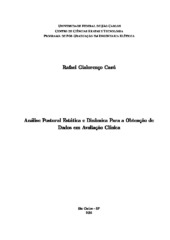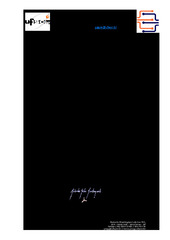| dc.contributor.author | Cazú, Rafael Gialorenço | |
| dc.date.accessioned | 2021-05-24T12:10:20Z | |
| dc.date.available | 2021-05-24T12:10:20Z | |
| dc.date.issued | 2021-02-05 | |
| dc.identifier.citation | CAZÚ, Rafael Gialorenço. Análise postural estática e dinâmica para a obtenção de dados em avaliação clínica. 2021. Dissertação (Mestrado em Engenharia Elétrica) – Universidade Federal de São Carlos, São Carlos, 2021. Disponível em: https://repositorio.ufscar.br/handle/ufscar/14298. | * |
| dc.identifier.uri | https://repositorio.ufscar.br/handle/ufscar/14298 | |
| dc.description.abstract | This research project makes use of kinematics for a study of the subject’s postural pattern,
through the processing of video images and with the use of a baropodometry platform. Men and
women aged between 18 and 60 years, who self-declared that they did not have joint dysfunction,
pain and physical or cognitive impairment, were subject to age. The analysis obtained two
postural patterns, the first non-static pattern and then a non-dynamic pattern in motion. In
the static pattern, an analysis was made through the baropodometry platform that presents the
pressures of loads and surfaces of the subjects’ plantar regions. In the dynamic pattern, the
subject was filmed in motion, in profile and posterior positions, allowing the reconstruction of a
model in three dimensions. For the analysis of the images of the videos, software was developed
in C ++ language that used the libraries for image processing, ac OpenCV and 3D visualization
called ac VTK. The information collected from this analysis served to compare the subject’s
movements evaluated in gait, associated with the image of the pressure of the step and the plantar
areas of the same subject, in order to determine patterns related to the types of steps with the
analysis of the dynamic patterns. The type of foot cava and the movements of the hip on the
skull-tail axis and the flexion and extension movements of the right hip were predominant in
this research. Therefore, it is feasible to use the programming for the professional’s clinical
reasoning, helping for a good conduct of assessment, diagnosis, orientation and monitoring of
developments in the treatment of physiotherapy. | eng |
| dc.description.sponsorship | Não recebi financiamento | por |
| dc.language.iso | por | por |
| dc.publisher | Universidade Federal de São Carlos | por |
| dc.rights | Attribution-NonCommercial-NoDerivs 3.0 Brazil | * |
| dc.rights.uri | http://creativecommons.org/licenses/by-nc-nd/3.0/br/ | * |
| dc.subject | Cinemática | por |
| dc.subject | Padrão da marcha | por |
| dc.subject | Processamento de imagem | por |
| dc.subject | Aprendizado de máquina | por |
| dc.subject | Kinematics | eng |
| dc.subject | Marching pattern | eng |
| dc.subject | Image processing | eng |
| dc.subject | Machine learning | eng |
| dc.title | Análise postural estática e dinâmica para a obtenção de dados em avaliação clínica | por |
| dc.title.alternative | Static and dynamic postural analysis to obtain data in clinical evaluation | eng |
| dc.type | Dissertação | por |
| dc.contributor.advisor1 | Montagnoli, Arlindo Neto | |
| dc.contributor.advisor1Lattes | http://lattes.cnpq.br/2903750902988624 | por |
| dc.description.resumo | Este projeto de pesquisa faz o uso da cinemetria para um estudo do padrão postural de sujeitos,
por meio de processamento de imagens de vídeo e com a utilização de uma plataforma de
baropodometria. Foram analisados sujeitos com idades entre 18 à 60 anos, homens e mulheres,
que se auto declararam não apresentar disfunção articular, quadro álgico e incapacidade física ou
cognitiva. A análise obteve dois padrões posturais, o primeiro no padrão estático e em seguida
no padrão dinâmico em marcha. No padrão estático, a análise foi feita através da plataforma
de baropodometria que apresentou as pressões de cargas e superfícies das regiões plantares
dos sujeitos. No padrão dinâmico foram realizadas filmagens do sujeito em movimento, nas
posições de perfil e posterior possibilitando a reconstrução de um modelo em três dimensões.
Para as análises das imagens dos vídeos foram desenvolvidos softwares em linguagem C++ que
utilizaram as bibliotecas para processamento de imagens, Open Source Computer Vision Library
(OpenCV) e de visualização em 3D chamada Visualization Tool Kit (VTK). As informações
colhidas desta análise serviram para a comparação dos movimentos do sujeito avaliado em
marcha, associado com a imagem da pressão da pisada e das áreas plantares do mesmo sujeito, a
fim de detectar possíveis padrões relacionados aos tipos de pisadas com a análise dos padrões
dinâmicos. O tipo de pisada cava e as movimentações do quadril no eixo crânio-caudal e
os movimentos de flexão e extensão do quadril direito, foram predominantes nesta pesquisa.
Portanto, é viável a utilização da programação para o raciocínio clínico do profissional, auxiliando
para uma boa conduta de avaliação, diagnóstico, orientações e acompanhamento nas evoluções
no tratamento da fisioterapia. | por |
| dc.publisher.initials | UFSCar | por |
| dc.publisher.program | Programa de Pós-Graduação em Engenharia Elétrica - PPGEE | por |
| dc.subject.cnpq | CIENCIAS DA SAUDE::FISIOTERAPIA E TERAPIA OCUPACIONAL | por |
| dc.subject.cnpq | ENGENHARIAS::ENGENHARIA ELETRICA | por |
| dc.publisher.address | Câmpus São Carlos | por |
| dc.contributor.authorlattes | http://lattes.cnpq.br/3573121458003350 | por |


